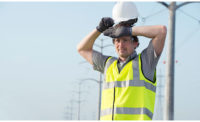Every spring, as the days get warmer and the weather gets consistently drier, the construction industry ramps up their projects and construction season officially begins. And with the onset of various projects between infrastructure, specialized industrial, institutional or commercial construction, it is the time of year that workers and safety managers alike should be refreshed on proper safety protocols while on the job.
Across the spectrum of jobs on construction worksites, workers face many jobsite hazards that can lead to injury or even worse: a fatality. Understanding the different hazards, properly training employees and providing the right personal protective equipment (PPE) solutions can help protect workers when and where they need it most.
The Fatal Four
OSHA defines the four main hazards within the construction industry as the “Fatal Four,” which account for the leading cause of workplace deaths: falls, electrocution, caught-in or between and struck-by incidents.
1. Falls
Falls are the number one cause of worker fatalities in construction. In 2020, 351 of the 1,008 total fatalities in construction were a result of falls. To help prevent falls, OSHA recommends employers plan ahead by discussing how the job will be done and what tasks will need to be completed to ensure safety. Then, employers should provide the right equipment for the specific tasks and train all workers to learn how to properly use the equipment.
2. Electrocution
Construction workers are approximately four times more likely to be electrocuted than workers in all other industries. Many construction electrocutions happen when workers encounter live electrical equipment, temporary power and overhead or underground power lines.
While electrical hazards are dangerous, risks can be reduced by implementing safe work practices. Workers should use caution around energized lines, de-energize equipment before repairing and wear appropriate PPE. Some safety eyewear, hard hats, fall protection, gloves and footwear are designed to help protect the wearer from electrocution by using dielectric PPE products and products with antistatic and electrostatic discharge features.
3. Caught-in or between
Caught-in or between hazards occur on construction sites when working around machinery that has unguarded moving parts, unprotected excavations or trenches and collapsing walls during demolition. Working around heavy equipment that tips over and moving vehicles or equipment can also result in caught-in or between incidents.
Employers can help protect workers by ensuring machines are properly guarded and training employees on how to follow safety procedures. Proper training and high visibility clothing can help prevent caught-in or between injuries.
4. Struck-by incidents
Struck-by injuries are the leading cause of nonfatal injuries and the second most common cause of fatalities among construction workers. These incidents mostly occur when workers are struck by heavy equipment or vehicles and falling or flying objects. Employers can help prevent struck-by incidents by providing training, inspecting equipment before use and providing the right PPE such as safety glasses, hard hats and face shields.
Understanding worksite risks leads to better safety outcomes
While the four hazards listed above are the most common causes of worker fatalities, they are not the only onsite risks construction workers face. For example, they risk hearing loss from exposure to loud machinery and drilling noises, or they can suffer hand injuries when manipulating metal, concrete, or other hard materials. Eyesight can also be compromised from sun exposure, haze, flying debris, dust, or even larger particles can harm a construction worker’s eyes if they aren’t wearing the proper safety eyewear.
Worksite dangers are everywhere, but the risks they pose can be reduced. Building a holistic culture of safety is critical to help ensure workers stay out of harm’s way throughout their entire shifts. For safety managers, here are three key things to remember: Understand the risks of each job, instill and reinforce safety best practices with proper training and equip workers with comfortable and well-fitted PPE that they will wear all day. In doing so, more lives will be protected not just during construction season but all year long.



